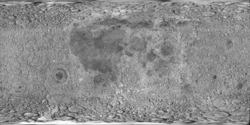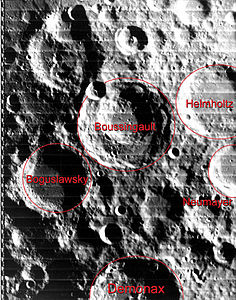Boussingault (cràter)
 | |
| Dades generals | |
| Tipus | cràter d'impacte i cràter lunar |
| Cos astronòmic | Lluna |
| Epònim | Jean Baptiste Boussingault |
| Dades geogràfiques | |
| Coordenades | 70° 13′ S, 53° 44′ E / 70.21°S,53.73°E |
| Diàmetre | 128 km |
| Profunditat | 3.200 m |
| Quadrangle | LQ30 |
| Localització | |
| Identificadors | |
| Gazetteer of Planetary Nomenclature | 844 |
Boussingault és un gran cràter d'impacte que es troba a prop de l'extremitat sud-est agrest de la Lluna. Per la seva ubicació, s'albira des de la Terra amb una forma molt oblonga, a causa de l'escorç. Al sud-oest apareix el cràter Boguslawsky, i gairebé unit a l'extrem nord-est se situa Helmholtz. A l'est-sud-est de Boussingault es troba el cràter Neumayer.
-
Localització de Boussingault (centre de la imatge)
-
Cràters satèl·lit
L'aspecte més notable d'aquest cràter és el segon gran cràter que es troba totalment dins de les seves parets, de manera que s'assembla a una formació de doble paret.
-
Fotografia de la missió LRO 4
La vora externa apareix desgastada, travessada en el seu costat nord-oest per Boussingault K i Boussingault G. Al nord-oest es troba el cràter de la formació de triple superposició formada per Boussingault E, B, i C.
Cràters satèl·lit
[modifica]Per convenció aquests elements són identificats en els mapes lunars posant la lletra en el costat del punt central del cràter que està més proper a Boussingault.
| Boussingault | Coordenades | Diàmetre |
|---|---|---|
| A | 69° 54′ S, 54° 00′ E / 69.9°S,54.0°E | 72 km |
| B | 65° 30′ S, 46° 54′ E / 65.5°S,46.9°E | 54 km |
| C | 65° 06′ S, 48° 12′ E / 65.1°S,48.2°E | 24 km |
| D | 63° 30′ S, 44° 54′ E / 63.5°S,44.9°E | 9 km |
| E | 67° 12′ S, 46° 48′ E / 67.2°S,46.8°E | 98 km |
| F | 68° 48′ S, 39° 24′ E / 68.8°S,39.4°E | 16 km |
| G | 71° 24′ S, 51° 48′ E / 71.4°S,51.8°E | 5 km |
| K | 68° 54′ S, 50° 54′ E / 68.9°S,50.9°E | 29 km |
| N | 71° 30′ S, 62° 06′ E / 71.5°S,62.1°E | 15 km |
| P | 67° 06′ S, 45° 06′ E / 67.1°S,45.1°E | 13 ;km |
| R | 64° 18′ S, 48° 36′ E / 64.3°S,48.6°E | 12 km |
| S | 64° 06′ S, 46° 54′ E / 64.1°S,46.9°E | 16 km |
| T | 63° 00′ S, 43° 12′ E / 63.0°S,43.2°E | 20 km |
Referències
[modifica]- (WGPSN), IAU Working Group for Planetary System Nomenclature. «Gazetteer of Planetary Nomenclature. 1:1 Million-Scale Maps of the Moon» (en anglès). UAI / USGS, 13-02-2013. [Consulta: 6 abril 2016].
- Andersson, L. E.; Whitaker, E. A.,. NASA Catalogue of Lunar Nomenclature (en anglès). NASA RP-1097, 1982.
- Blue, Jennifer. «Gazetteer of Planetary Nomenclature» (en anglès). USGS, 25-07-2007. [Consulta: 2 gener 2012].
- Bussey, B.; Spudis, P.. The Clementine Atlas of the Moon (en anglès). Nueva York: Cambridge University Press, 2004. ISBN 0-521-81528-2.
- Cocks, Elijah E.; Cocks, Josiah C.. Who's Who on the Moon: A Biographical Dictionary of Lunar Nomenclature (en anglès). Tudor Publishers, 1995. ISBN 0-936389-27-3.
- McDowell, Jonathan. «Lunar Nomenclature» (en anglès). Jonathan's Space Report, 15-07-2007. [Consulta: 2 gener 2012].
- Menzel, D. H.; Minnaert, M.; Levin, B.; Dollfus, A.; Bell, B. «Report on Lunar Nomenclature by The Working Group of Commission 17 of the IAU» (en anglès). Space Science Reviews, 12, 1971, pàg. 136.
- Moore, Patrick. On the Moon (en anglès). Sterling Publishing Co, 2001. ISBN 0-304-35469-4.
- Price, Fred W. The Moon Observer's Handbook (en anglès). Cambridge University Press, 1988. ISBN 0521335000.
- Rükl, Antonín. Atlas of the Moon (en anglès). Kalmbach Books, 1990. ISBN 0-913135-17-8.
- Webb, Rev. T. W.. Celestial Objects for Common Telescopes, 6ª edición revisada (en anglès). Dover, 1962. ISBN 0-486-20917-2.
- Whitaker, Ewen A. Mapping and Naming the Moon (en anglès). Cambridge University Press, 2003. 978-0-521-54414-6.
- Wlasuk, Peter T. Observing the Moon (en anglès). Springer, 2000. ISBN 1-85233-193-3.





